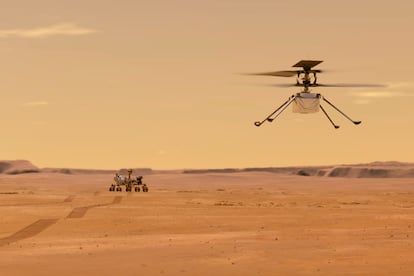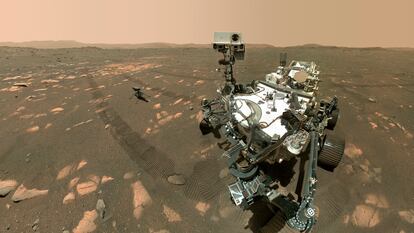‘Ingenuity’: a helicopter that will fly over Mars
Questions and answers about the work that the ‘companion’ of ‘Perseverance’ will be carrying out, and which is due to take its maiden flight in the coming days
The Perseverance explorer, which has been on the Jezero crater of Mars for more than a month now, isn’t alone. It took a small helicopter with it, one that goes by the name of Ingenuity. Until now it has been in the storage space of the larger craft, folded up to occupy the smallest space possible and covered to protect it from dust and rocks that were kicked up during landing.
These last weeks have been spent testing and calibrating the cameras and mechanisms on board, a long and complicated task. Perseverance has moved around 100 meters, in search of a flat space to deposit the helicopter – a Martian heliport, if you will. The protective elements have since been removed and the connecting cables uncoupled.
Perseverance has also released the clamps that held the helicopter in place, allowing it to unfold its four fragile legs and fall to the ground. The vehicle will later reverse and move to a safe distance, leaving a clear space and letting Ingenuity charge its batteries using solar power.
It will have the entire Martian sky at its disposal when it takes its first flight, which was originally planned for April 12, but has now been delayed until April 14.
Here are answers to some of the frequently asked questions about the exploration of the red planet.
Why put a helicopter on Mars? Ingenuity represents the testing of a concept, an exercise in engineering. It will not be carrying out scientific or exploration tasks. It is to demonstrate that it can fly in an environment as hostile and unknown as the Martian atmosphere.
Does it work like a conventional helicopter? Mostly, yes. It uses twin rotors, with one of the blades revolving in one direction and the other in the opposite, to compensate the movement and stop the vehicle from spinning. That is why it doesn’t need a tail rotor. In this sense, it is closer to a drone than a helicopter.
Will it be able to maneuver in Mars’ thin atmosphere? That is what will be tested. The density of the air is barely a hundredth of that of the Earth, equivalent to what you would find at 30,000 meters. No conventional aircraft flies that high, and certainly not a helicopter, whose operational ceiling is way below 8,000 meters. In order to take off, the rotors will spin at around 2,400 revolutions a minute, close to the speed of a blender and five times faster than the blades of a conventional helicopter. The situation is so delicate that the flights have been planned for just after midday on the planet, when the density of the air should haven increased by a tiny amount and will help with lift.
Why has this design been chosen and not the typical one used for drones? For a very simple reason: it wouldn’t have fit. In order to fly in the thin Martian air, Ingenuity needs very big blades, measuring more than a meter in diameter but weighing (on Mars) less than a kilo. They are not foldable and fit snugly underneath Perseverance. A quadcopter would not have fitted there.
Has it been tested on Earth? As far as possible. Its design is mostly based on mathematical models using what is known about the Martian atmosphere and climate. The prototype has flown inside a vacuum chamber, but only after it was made lighter in order to simulate lower gravity. As such, the rehearsals were only done using the propulsion system and landing gear – its navigation electronics and batteries were left on the ground, connected to the helicopter via a cable. The only testing under real conditions can be done on Mars.

Is it autonomous? It has to be. Radio signals take more than 10 minutes to reach Mars from Earth. This delay means that it is impossible to control a helicopter – or practically any other kind of vehicle – from the Earth. That said, autonomous does not necessarily mean “intelligent.” Ingenuity’s flights have been planned in advance. The instructions for take-off, altitude and route were stored in its memory long before the flight will begin, and the craft will follow them as best as it can. Its capacity for decision making is limited to correcting deviations due, for example, to gusts of wind.
In the future, other models may be able to understand more complex orders, such as “travel to that rock avoiding protrusions from the ground” (this is something that Perseverance knows how to do, to a certain point).
Is it carrying a flight computer on board? Yes, it’s a commercial unit, and very similar to the one in the cellphone that you’ve got in your pocket. It doesn’t have a lot of memory, two gigabytes of RAM and 32 of ROM, about the same as a basic phone. But it does have a much better battery life, and also a small panel of solar cells to recharge it, as well as to power heaters that protect it from the very cold nights on Mars.
Will it broadcast images? Yes, directly to Perseverance and from there to Earth. One of its cameras, in black and white, points directly down to the ground. It only has a modest quality, a bit like the VGA from our old computers. The other camera is high definition, and is pointed forward at an oblique angle. The latter promises to provide the most spectacular images, with a quality in excess of 4K.
What kind of autonomy does it have? Ninety seconds of flight. Its small batteries don’t last any longer. In that time, it can reach a ceiling of 10 meters of altitude and move around 300 meters at most. The first flight will involve a vertical ascent up to three meters. It will then rotate, as if it were scanning the horizon, and then land. Nothing spectacular. Later attempts should see it fly higher and further.
Will it accompany Perseverance on its exploration of the crater? No. Perseverance has its own program of experiments and the helicopter, a last-minute stowaway, is not among them. The flight team was given around a month for its tests. In total, it is due to make five flights. Then Ingenuity will land more or less where it is now, and Perseverance will head off to do its tasks, leaving it abandoned even if its equipment is still in perfect working order.
Rafael Clemente is an industrial engineer and was the founder and first director of the Museu de la Ciència de Barcelona (now known as CosmoCaixa).
Tu suscripción se está usando en otro dispositivo
¿Quieres añadir otro usuario a tu suscripción?
Si continúas leyendo en este dispositivo, no se podrá leer en el otro.
FlechaTu suscripción se está usando en otro dispositivo y solo puedes acceder a EL PAÍS desde un dispositivo a la vez.
Si quieres compartir tu cuenta, cambia tu suscripción a la modalidad Premium, así podrás añadir otro usuario. Cada uno accederá con su propia cuenta de email, lo que os permitirá personalizar vuestra experiencia en EL PAÍS.
¿Tienes una suscripción de empresa? Accede aquí para contratar más cuentas.
En el caso de no saber quién está usando tu cuenta, te recomendamos cambiar tu contraseña aquí.
Si decides continuar compartiendo tu cuenta, este mensaje se mostrará en tu dispositivo y en el de la otra persona que está usando tu cuenta de forma indefinida, afectando a tu experiencia de lectura. Puedes consultar aquí los términos y condiciones de la suscripción digital.
More information
Archived In
Últimas noticias
Raúl Rocha, from jet-setting with Miss Universe to arms trafficking and fuel theft
80,000 barrels of Mexican oil sent to Cuba: Havana drawn into the US–Mexico clash
Human rights activists, opposition members, and a minor: Maduro’s other political prisoners
Israel sparks a civil war within the MAGA movement
Most viewed
- Reinhard Genzel, Nobel laureate in physics: ‘One-minute videos will never give you the truth’
- Pablo Escobar’s hippos: A serious environmental problem, 40 years on
- Charles Dubouloz, mountaineering star, retires at 36 with a farewell tour inspired by Walter Bonatti
- Why we lost the habit of sleeping in two segments and how that changed our sense of time
- The fall of a prolific science journal exposes the billion-dollar profits of scientific publishing












































